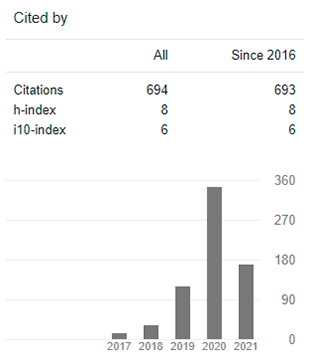Sherlock Holmes and abductive reasoning: A semiotic look at scientific discourse
DOI:
https://doi.org/10.29394/Scientific.issn.2542-2987.2019.4.14.20.411-425Keywords:
reasoning, speech, science fiction, semiologyAbstract
This essay presents a semiotic look at scientific discourse. For its interpretation, an analysis was made of the discursive enunciation of Sherlock Holmes' fictional series "The Sign of the Four", in which the semiotic actor represents a private detective, who adopts the abductive method to clarify the different cases. The film director encourages the viewer to enter a possible world with elements of drama and suspense, in order to keep his attention throughout the film. The investigation finds its support in the works of the philosopher and logic Charles Sanders Peirce (1893-1914), most of whom used abductive reasoning as a method for the search for truth through well-executed conjectures. The results obtained show that the semiotic object used for its analysis, from the Peircean notion, is aimed at establishing a binding semiosis between detective cases and the diagnoses of a doctor, and that the Scottish writer Arthur Conan Doyle (1859-1930) left for posterity a hero prefigured in the fictitious characters of Sherlock Holmes and Dr. John H. Watson.
Downloads
References
Bordwell, D. (1995). El significado del filme: Inferencia y retórica en la interpretación cinematográfica. Barcelona, España: Ediciones Paidós.
Carmona, R. (1991a,b). Cómo se comenta un texto fílmico. Madrid, España: Ediciones Cátedra.
Casetti, F., & Di Chio, F. (1990a,b,c). Cómo analizar un film. Barcelona, España: Ediciones Paidós.
Casetti, F. (2005). Teorías del Cine. Madrid, España: Ediciones Cátedra.
Doyle, A. (1890a,b). El signo de los Cuatro. Londres, Inglaterra: Heinemann Educational Books.
Eco, U., & Sebeok, T. (1989a,b). El signo de los tres: Dupin, Holmes y Peirce. Barcelona, España: Editorial Lumen.
García, J. (2011a,b). Manual de Semiótica: Semiótica narrativa, con aplicaciones de análisis en comunicaciones. Lima, Perú: Instituto de Investigación Científica de la Universidad de Lima. Recuperado de: https://www.academia.edu/
Konnikova, M. (2013). ¿Cómo pensar como Sherlock Holmes? Barcelona, España: Ediciones Paidós Ibérica.
Maita, M. (2018). Estilos de Pensamiento y Enfoques Epistemológicos. Revista Scientific, 3(7), 374-393, e-ISSN: 2542-2987. Recuperado de: https://doi.org/10.29394/Scientific.issn.2542-2987.2018.3.7.19.374-393
Peirce, C. (1958a,b,c,d,e). Collected Papers of Charles Sanders Peirce. Cambridge, Inglaterra: Harvard University Press.
Riofrío, J. (2015). La selección del método en la investigación jurídica. 100 métodos posibles. Revista de Educación y Derecho, (12), 1-27, ISSN: 2013-584X e-ISSN: 4885. Recuperado de: http://revistes.ub.edu/index.php/RED/article/view/14402/17642
Zavala, L. (2005). Cine Clásico, Moderno y Posmoderno. Razón y Palabra, (46), 1-11, e-ISSN: 1605-4806. Recuperado de: http://www.redalyc.org/articulo.oa?id=199520647003
Downloads
Published
How to Cite
Issue
Section
License
Copyright (c) 2019 INDTEC, C.A.

This work is licensed under a Creative Commons Attribution-NonCommercial-ShareAlike 4.0 International License.
The content of the journals of this site, are under a Creative Commons Attribution-Noncommercial-Share Alike 4.0 International License.













